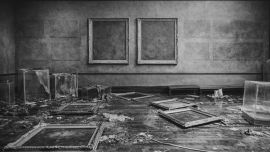The remains of the submarine found seven months ago near Necochea, southwest Buenos Aires Province, which had been deliberately sunk in 1945, belong to a ship from the German Kriegsmarine (Navy), an Italian investigative unit has determined.
According to the Eslabón Perdido group, the Italian Naval League has confirmed that the submarine is of German origin, a type VII or IX U-Boat.
"After an investigation, naval experts have determined that the wreckage is compatible with that of a submarine and not a conventional ship," Carlos Palotta, one of the group's collaborators, said on Tuesday.
Eslabón Perdido is a group of volunteers, led by historian and researcher Abel Basti, who search to find the hulls of sunken Nazi submarines which, towards the end of World War II, arrived quietly into Argentina and were sunk in order to cover up traces of their arrival.
An expert report, signed by naval submarine expert Fabio Bisciotti, coincides with the findings of another put together by Argentina's Coast Guard.
"It was deliberately sunk," said Bisciotti, recalling that this was a common practice when the crew of a ship, or a submarine, in this case, surrendered, so as not to leave traces.
The Italian expert indicated that the hull is "semi-buried, with a high degree of destruction,” and added that, "some details stand out in the photos that can be easily compared with the structures that represent the skeleton of a U-Boat."
"There are reports from the time that speak of a landing of Nazi hierarchs in the area," said Basti, of Eslabón Perdido.
"In the winter of 1945, the commissioner of Necochea received a report of landings in the area. The commissioner went there that day and noticed that there were footprints coming from the sea. And tyre tracks," he added.
A periscope was one of the ship's key identifying factors. Investigators also spotted body features that are characteristic of a U-Boat, noting “the distinctive shape attributable to a turret deflector."
Argentina's Coast Guard used a remote-controlled vehicle to take pictures of the Nazi submarine, with tactical divers also participating in the operation, which occurred at a depth of 28 metres. The remains of the ship have been scattered in an area that is about 80 metres long by 10 metres wide.
The wreckage lies around four kilometres off coast of Costa Bonita and Arenas Verdes beaches in Buenos Aires, at a depth of 28 metres.
Historical records have shown that many Nazi officers escaped in such ships after the Allied victory in World War II. Many who departed chose Argentina as a refuge, either temporarily or permanently.
Some have even gone as far as theorising that Adolf Hitler fled to Argentina — contrary to the widely accepted version of events that the Nazi leader committed suicide in Germany along with his partner, Eva Braun, when the outcome of the war became inevitable.
—TIMES/NA



















Comments